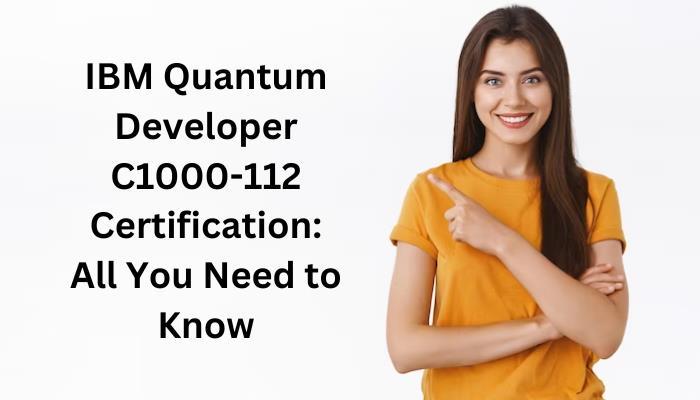

Introduction to C1000-112 IBM Certified Associate Developer - Quantum Computation using Qiskit v0.2X Exam
The IBM C1000-112 exam is challenging and thorough preparation is essential for success. This exam study guide is designed to help you prepare for the Quantum Developer certification exam. It contains a detailed list of the topics covered on the Professional exam, as well as a detailed list of preparation resources. This study guide for the IBM Fundamentals of Quantum Computation Using Qiskit v0.2X Developer certification will help guide you through the study process for your certification.
C1000-112 IBM Fundamentals of Quantum Computation Using Qiskit v0.2X Developer Exam Summary

● Exam Name: IBM Fundamentals of Quantum Computation Using Qiskit v0.2X Developer
● Exam Code: C1000-112
● Exam Price: $200 (USD)
● Duration: 90 mins
● Number of Questions: 60
● Passing Score: 73%
C1000-112: IBM Fundamentals of Quantum Computation Using Qiskit v0.2X Developer
● Reference Books: Qiskit Developer Certification Syllabus, Study Guide
● Schedule Exam: Pearson VUE
● Sample Questions: IBM Quantum Developer Sample Questions
● Recommended Practice: IBM C1000-112 Certification Practice Exam
Exam Syllabus: C1000-112 IBM Certified Associate Developer
- Quantum Computation using Qiskit v0.2X Topic Details
- Construct multi-qubit quantum registers
- Measure quantum circuits in classical registers
- Use single-qubit gates
- Use multi-qubit gates
- Use barrier operations
- Return the circuit depth
-
C1000-112: IBM Fundamentals of Quantum Computation Using Qiskit v0.2X Developer
Access Aer Provider
- Access a statevector_simulator backend
- Access a qasm_simulator backend
- Access a unitary_simulator backend
IBM C1000-112 Certification Sample Questions and Answers
To make you familiar with the IBM Fundamentals of Quantum Computation Using Qiskit v0.2X Developer (C1000-112) certification exam structure, we have prepared this sample question set. We suggest you try our Sample Questions for Qiskit Developer C1000-112 Certification to test your understanding of the IBM C1000-112 process in the real IBM certification exam environment.
C1000-112 IBM Fundamentals of Quantum Computation Using Qiskit
v0.2X Developer Sample Questions:-
01. Which statement will create a quantum circuit with four quantum bits and four classical bits?
a) QuantumCircuit(4, 4)
b) QuantumCircuit(4)
c) QuantumCircuit(QuantumRegister(4, 'qr0'), QuantumRegister(4, 'cr1'))
d) QuantumCircuit([4, 4])
02. Which line of code would assign a statevector simulator object to the variable backend?
a) backend = BasicAer.StatevectorSimulatorPy()
b) backend = BasicAer.get_backend('statevector_simulator')
c) backend = BasicAer.StatevectorSimulatorPy().name()
d) backend = BasicAer.get_back('statevector_simulator')
03. Which two options would place a barrier across all qubits to the QuantumCircuit below?
qc = QuantumCircuit(3,3)
a) qc.barrier(qc)
b) qc.barrier([0,1,2])
c) qc.barrier()
d) qc.barrier(3)
e) qc.barrier_all()
C1000-112: IBM Fundamentals of Quantum Computation Using Qiskit v0.2X Developer 3
04. Given this code fragment, what is the probability that a measurement would result in |0>?
qc = QuantumCircuit(1)
qc.ry(3 * math.pi/4, 0)
a) 0.8536
b) 0.5
c) 0.1464
d) 1.0
05. Which code fragment would yield an operator that represents a single-qubit X gate?
a) op = Operator.Xop(0)
b) qc = QuantumCircuit(1)
qc.x(0)
op = Operator(qc)
c) op = Operator([[0,1]])
d) op = Operator([[1,0,0,1]])
06. Which code fragment will produce a multi-qubit gate other than a CNOT?
a) qc.cx(0,1)
b) qc.cnot(0,1)
c) qc.mct([0],1)
d) qc.cz(0,1)
07. S-gate is a Qiskit phase gate with what value of the phase parameter?
a) π/8
b) π/4
c) π
d) π/2
08. What would be the fidelity result(s) for these two operators, which differ only by global phase?
op_a = Operator(XGate())
op_b = numpy.exp(1j * 0.5) * Operator(XGate())
a) state_fidelity() of 1.0
b) state_fidelity() and average_gate_fidelity() of 1.0
c) average_gate_fidelity() and process_fidelity() of 1.0
d) state_fidelity(), average_gate_fidelity() and process_fidelity() of 1.0
C1000-112: IBM Fundamentals of Quantum Computation Using Qiskit v0.2X Developer
09. Which code fragment will produce a maximally entangled, or Bell, state?
a) bell = QuantumCircuit(2)
bell.h(0)
bell.x(1)
bell.cx(0, 1)
b) bell = QuantumCircuit(2)
bell.cx(0, 1)
bell.h(0)
bell.x(1)
c) bell = QuantumCircuit(2)
bell.h(0)
bell.x(1)
bell.cz(0, 1)
d) bell = QuantumCircuit(2)
bell.h(0)
bell.h(0)
10. Which three simulators are available in BasicAer?
a) qasm_simulator
b) basic_qasm_simulator
c) statevector_simulator
d) unitary_simulator
e) quantum_simulator
f) quantum_circuit_simulator
